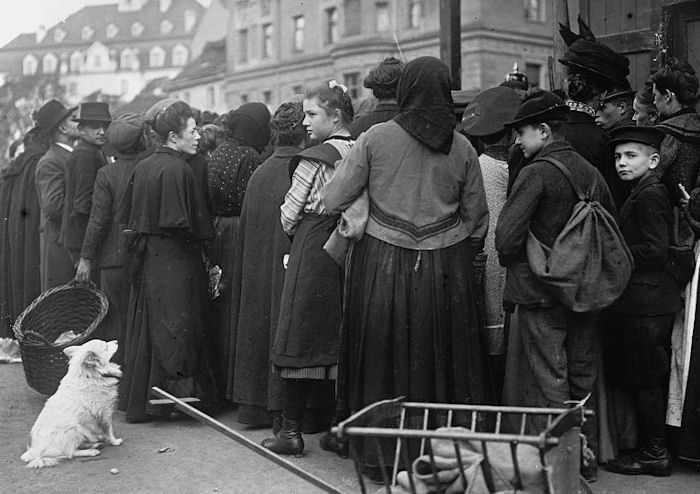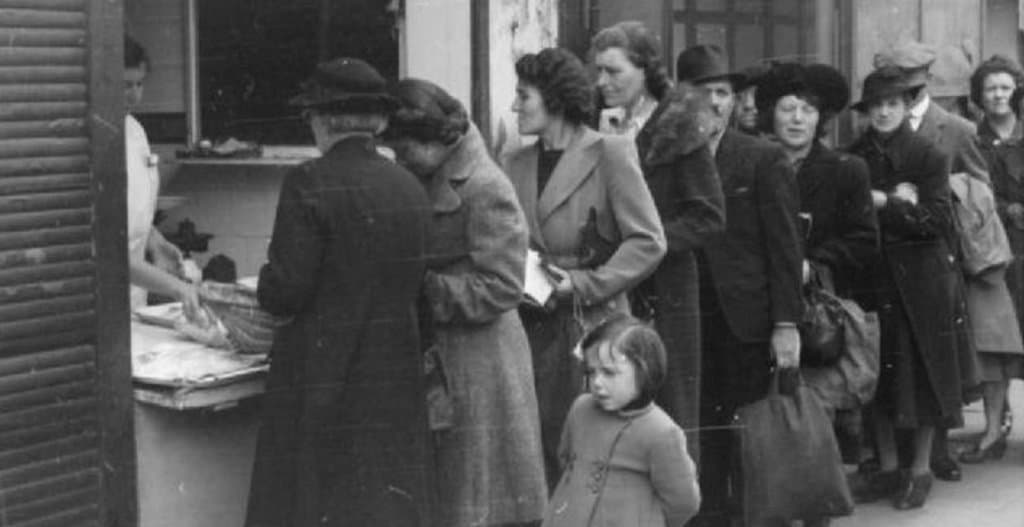Rationing And Food Shortages During World War 1
After the attack on Pearl Harbor the economy shifted to war production. The Defence of the Realm Act DORA was enforced to ensure that food shortages did not occur so rationing kept the public from facing starvation.
The Ministry of Food was responsible for overseeing rationing.

Rationing and food shortages during world war 1. Butter wheat tea and sugar were in short supply and the ration for sugar in Britain was reduced from 8oz 225g per person per week to 6oz. Up to that point in the First World War food shortage had a. At the start of World War One any food shortages were self-imposed.
July 1948 Bread came off ration. Sugar was the first to be rationed and this was later followed by butchers meat. Shortages Conserving and Rationing.
Rationing was enforced by the use of coupons and was limited to clothing tea sugar butter and meat. At the beginning of the Second World War Britain imported 60 of its food. Newspapers published special war menus.
It was also the only way to make sure that everybody got a fair share. 1920 was dominated by world food shortages caused by a combination of the war and the 1918 flu pandemic which had a catastrophic effect on production and transport. During the war the US was forced to ration and conserve because of shortages.
Rationing was a response to a U-boat campaign carried out by the Germans which resulted in a loss of supplies. It made sure everyone in the country got what. One of the primary aims of DORA when it was first introduced was to prevent food shortages.
Propaganda posters urged fuel-less Sundays meatless Fridays and the elimination of wasteful shopping and cooking practices. Food rationing was tightened up. Agriculture and food distribution suffered from strains imposed by the war and naval blockades reduced food imports.
People were only allowed certain amounts of sugar meat flour butter and milk. In January 1940 the British government introduced food rationing. The idea of rationing food was to guarantee supplies not to reduce consumption.
Every man woman and child received a ration book and each home had to register with a local butcher grocer and milkman who received enough food for. During the First World War. From time to time eggs and milk were also rationed under a system of priority for vulnerable groups during periods of shortage.
With the shortage of food during the First World War still fresh in the memory the government introduced the food rationing scheme in January 1940. Some countries met this threat more successfully than others. They were also provided with vegetables bread cheese sugar tea condiments and tobacco.
The butter ration was cut to 2 ounces sugar to 8 ounces and uncooked bacon to 4 ounces. Teachers in elementary schools took up the challenge and cookery centres were established in Preston. By not consuming as much bread civilians saved grain for the war effort.
At the end of 1917 people began to fear that the country was running out of food. Panic buying led to shortages and so in January 1918 the Ministry of Food decided to introduce rationing. December 1948 Marmalade jam treacle and syrup came off ration.
Rationing of certain foods was introduced in 1918 close to the end of World War One after German submarines had succeeded in sinking ships carrying imports into Britain. The Defence of the Realm DORA was used to ensure that food shortages never occurred. Rationing was introduced in response to an effective U-boat campaign and during World War One the Defence of the Realm Act DORA was used to ensure that food shortages never occurred.
During this period of austerity housewives acquired an increased status because the successful implementation of rationing and. Provinces and municipalities managed local hydro and power shortages sometimes by short-term closures in schools and factories. Bread was rationed from 1946 to 1948 and potatoes for a year from 1947.
Those not serving in the forces were mobilized in a nationwide Home Guard. Rationing In The Second World War. Rationing and shortages in WW1.
In 1918 new laws set by the government introduced rationing a way of sharing food fairly. Because of a shortage of cloth the Government even made rules about how many pockets a mans suit could have and banned the making of luxury garments for women. British soldiers for example were provided with 125 pounds of fresh meat or 1 pound of salted meat daily.
Australians could have 226 grams of butter one kilo of meat and half a kilogram of sugar each per week. Hunger stalked the civilian populations of all the combatant nations. Rationing is a fixed allowance of provisions or food especially for soldiers sailors civilians during a shortage.
May 1950 Canned and dried fruit came off. A scheme of voluntary rationing was promoted on 1 February 1917 with the aim of reducing the consumption of food in short supply and to show how to avoid waste when cooking. Margarine and other fats were included at last and - the cruellest blow of all - tea rationing was introduced at the devastating rate of 2 ounces per week.
Every man woman and child was given a ration book with coupons. Food rationing lasted for 14 years from 1940 to 1954. So following some research I would like to share with you some the memories of shortages and rationing recorded by the Imperial War museum Formal rationing was not introduced in Britain until February 1918.
However neither of my parents ever mentioned any sort of rationing or shortages in their childhood and my mother in her extensive. Some of the wartime food rations. Rationing meant that people were only allowed to buy a small amount of everyday items.
Rationing was administered by. In the Second World War the civilian population had to cope with extensive rationing of food and clothing as well as severe shortages of other consumer goods as economic resources were diverted towards the war effort. Gradually foods came off ration.
Rationing happens mostly in wartime cases. The scheme was designed to ensure fair shares for all at a time of national shortage. Two new foods were rationed after the war.
Sugar meat flour butter margarine and milk were all rationed so that everyone got what they needed. By the end of the war restrictions on processed foods and other goods like gasoline and fuel oil were lifted but the rationing of sugar remained in effect until 1947. Rationing and Food Shortages.
Food rationing for troops began at the beginning the war.

File Britain Queues For Food Rationing And Food Shortages In Wartime London England Uk 1945 D25033 Jpg Wikimedia Commons

700 Allotment Plots Ww1 Food Shortages And Rationing Mylearning

A History Of The First World War In 100 Moments On The Streets Of Berlin Faces Ravaged By Hunger The Independent The Independent

The History Place World War I Timeline 1916 Food Shortages At Home

700 Allotment Plots Ww1 Food Shortages And Rationing Mylearning

Komentar
Posting Komentar